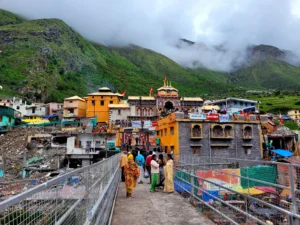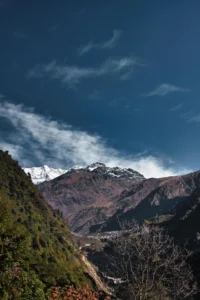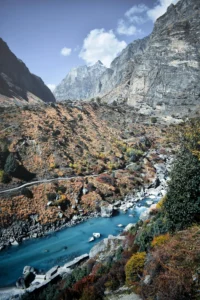There are places that you hear about growing up, and they just stick with you. For a lot of people in India, Badrinath Temple is one of those places. Nestled up in the Himalayas, surrounded by snow peaks and that icy silence you only find in the hills, this temple isn’t just a destination it’s an emotion. Whether you’re religious or just someone chasing peace and perspective, Badrinath has a way of making you stop and really feel the moment.
Now, about its history there’s no official date marked in stone, but the stories go way back. Way, way back. Some say Lord Vishnu meditated here, and his consort Lakshmi protected him by turning into a Badri tree. That’s where the name came from Badrinath, the Lord of Badri. Over the centuries, people have built shrines, rebuilt them, watched them fall to the weather, and built them again. But what stands today owes a lot to Adi Shankaracharya. He’s said to have revived the place in the 8th century and gave it the spiritual spotlight it holds now.
But it’s not just the age or the myth that makes it sacred. It’s the energy of the place. People walk mileto get there, not for luxury or comfort, but for a glimpse of the deity inside. The idol itself is made of black stone, seated in meditation. Peaceful. Still. Some say just standing there feels like a blessing.
For believers, it’s part of the Char Dham yatra. But for anyone, religious or not, it’s one of those rare places where something just feels right.

Table of Contents
ToggleRituals inside Badrinath
Stepping into the temple, you might expect chants echoing off ancient walls and incense hanging heavy in the air and you’d be right. But it’s not just dramatic rituals and fire-lit ceremonies all day. There’s a rhythm here, and it begins early.
Before sunrise, the temple priests called Rawals perform the Mahabhishek, a ritual where the idol of Lord Vishnu is gently bathed with milk, honey, ghee, and even tulsi water. It’s quiet, spiritual, and oddly grounding. You’d think such an important place would feel rushed and crowded, but the mornings here feel like the calm before the storm.
Later in the day, you’ll see the idol dressed in fresh clothes, flowers, and ornaments. The priests conduct pujas, and there’s a lot of devotion but also discipline. Every step, every chant has been passed down over generations.
By evening, the Aarti fills the temple with flickering flames and rhythmic bells. It’s hard not to feel moved even if you’re just a tourist who wandered in out of curiosity.
The interesting bit? The head priest, or Rawal, isn’t from Uttarakhand. He’s traditionally chosen from the Namboodiri Brahmin community of Kerala. That tiny detail shows how spiritual unity flows across regions in India.

Best time to visit Badrinath dham
The temple doesn’t stay open all year. Winters hit hard in the Himalayas, and from around November to April, everything shuts down. The idol is shifted to Joshimath, where prayers continue through the colder months.
So, the sweet spot? Mid-May to early October. That’s when the weather is friendly enough for travel. Try to avoid July and August unless you don’t mind rain and roadblocks. Monsoon season can be messy with landslides in the mountains.
If you’re someone who loves festivals, visiting during Badri-Kedar Utsav or Mata Murti Ka Mela brings a different energy. The place turns vibrant with music, colour, and community celebrations.

How to reach Badrinath?
Reaching Badrinath isn’t as simple as booking a cab and heading out. It’s a proper mountain journey. The nearest big railway station is Rishikesh, and the closest airport is Jolly Grant in Dehradun. From either, you’ll need to travel around 10–12 hours by road to get to the temple.
People usually break the journey at Joshimath, a charming hill town with basic hotels and great views. From there, Badrinath is about 45 km away. You can take a shared jeep or taxi, but brace yourself for narrow roads and hairpin bends.
Travel Tips for Badrinath yatra
Now, let’s get real. Badrinath is beautiful, but it’s also remote. And remote means not everything is going to go smoothly. So here are a few tips from folks who’ve been there.
First up, layer up. Even in summer, the evenings can get chilly. And if you’re someone who gets cold easily, bring gloves, a proper jacket, and maybe even woolen socks. Trust me, you’ll be glad you did during the early morning Aarti.
Footwear matters. You’ll walk quite a bit, and some paths can be uneven or wet. Waterproof shoes or at least something with a strong grip will save you from slipping or sore feet.
If you’re planning to travel with elderly family members, talk to your driver or hotel about palkis or porters. The walk from the parking area to the temple isn’t long, but at high altitudes, even short distances can feel exhausting.
Now, don’t expect fancy cafés or continental food. This is the hills, not a holiday resort. Local food like rajma chawal, aloo-puri, and hot cups of chai will be your saviours. Also, carry some dry snacks and water especially during the road journey.
And oh, a big one: network connectivity. It’s patchy. You may not get a signal for hours, so don’t rely on Google Maps or WhatsApp to save the day. Keep some cash handy too, because not every shop takes UPI up there.

It’s hard to explain what Badrinath does to people. Maybe it’s the crisp air, or the stories passed down for generations, or the way strangers smile at you just because you’re all on the same path.
It’s not a luxury trip. It’s not Instagram-perfect every second. But what you take back whether it’s a sense of stillness, a renewed belief in something bigger, or just the pride of making it to such a powerful place is priceless.
Some places you visit. Others you carry with you.
Badrinath? That’s the latter.


